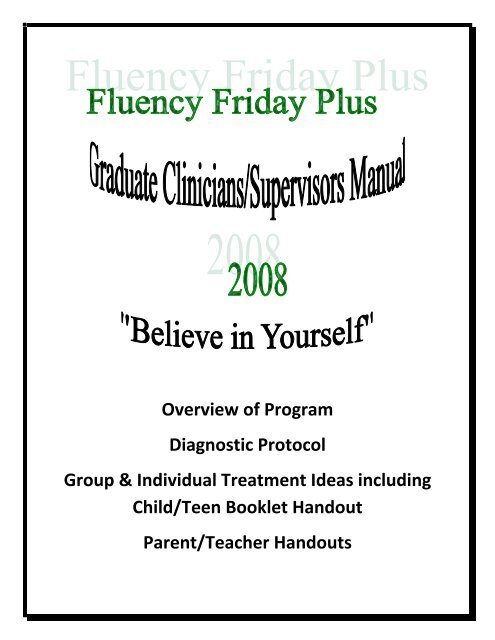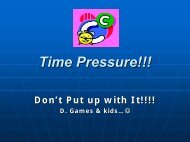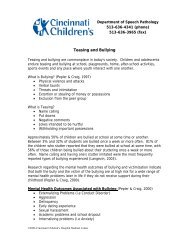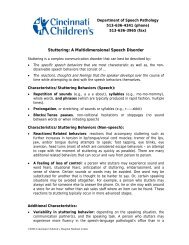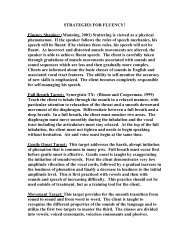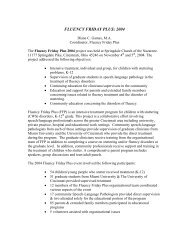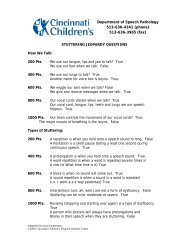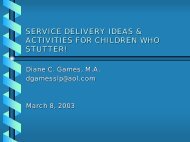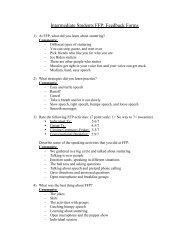Stuttering - Fluency Friday Plus
Stuttering - Fluency Friday Plus
Stuttering - Fluency Friday Plus
- No tags were found...
You also want an ePaper? Increase the reach of your titles
YUMPU automatically turns print PDFs into web optimized ePapers that Google loves.
OverviewofProgramDiagnosticProtocolGroup&IndividualTreatmentIdeasincludingChild/TeenBookletHandoutParent/TeacherHandouts
<strong>Fluency</strong> <strong>Friday</strong> <strong>Plus</strong>!<strong>Fluency</strong> <strong>Friday</strong> <strong>Plus</strong> (FFP) is an intensive treatment program for children/teens whostutter. This program serves students from Kindergarten through High School. Thisproject is a collaborative effort involving speech/language professionals from university,private practice, hospital and educational work settings. Community speech-languagepathologists from each of these settings provide supervision of graduate clinicians fromMiami University and the University of Cincinnati who provide the treatment during theprogram. The graduate clinicians receive training from the organizational team of FFP inaddition to completing a course on stuttering at the graduate level.During the day and one-half event, <strong>Fluency</strong> <strong>Friday</strong> <strong>Plus</strong> activities include: Individual & Group Treatment: The children/teens who stutter attend bothindividual and peer group sessions. In addition to practicing fluency targets, issuessuch as attitudes about speaking and the emotional aspects of dealing with astuttering disorder area are addressed. Role Playing/Skits: Opportunities are designed for children/teens to “act out”various situations concerning feelings, difficult speaking situations and dealing withcomments or teasing. Skits are shared with parents at the end of the day. Open Microphone: During the lunch hour of the first day, children/teens areencouraged to speak to the participants in the auditorium using a microphone. Inthis supportive environment, a number of students feel free to tell jokes and stories. Conversational Breakfast: This breakfast is held Saturday morning to provideopportunities to practice social conversation. Eleven Conversational Stations are setup by the graduate clinicians to encourage the children/teens to practice thetelephone; read out loud to a group; handle teasing; ask and answer questions; tell astory; do a one minute monologue; learn a card trick and teach it to someone; fakestuttering for one minute; persuade someone; be interviewed; and tell someone youstutter. In addition to the breakfast, the children/teens work to earn raffle ticketsby interacting with other children/teens/graduate clinicians/supervisors andparents. A drawing for the baskets filled with donated items is held on Saturdaymorning. Parent Training: An educational program for the parents, teachers and extendedfamily members provide opportunities for parents to enter into discussions on topicsof concern or interest. In addition, lectures by experts in the field of stuttering arescheduled. Topics consist of education about the causes and treatment of stuttering.Discussion also occurs on ways to help your child. Teen Panel: A group of teens who stutter meet with the parent group to answerquestions and to share their experiences. This forum enables the teens to speak
freely to a large, “listener friendly” audience who respect their courage and valuetheir unique insights into living with stuttering. Adults with <strong>Stuttering</strong> Speak: On Saturday morning, adults who stutter present aninformal seminar to the parent group reflecting on their personal experiencesgrowing up with stuttering, dealing with other topics generated by the parent group. Web Page/Graduate Clinicians/Supervisors Manual: The <strong>Fluency</strong> <strong>Friday</strong> web pageis updated each year and can be viewed at www.fluencyfriday.org. The web sitefacilitates the distribution of information about FFP including handouts used in thisprogram. In addition to the web page, all graduate clinicians and supervisorsreceive a manual containing all of the handouts from FFP.Graduate clinicians are assigned to one or two CWS. Where possible, thegraduate clinicians contact the professionals, the parents and the child/teen prior toFFP. During FFP, the graduate students collect speaking samples, administerattitudinal scales, develop speaking hierarchies and complete rating scales. Thegraduate clinicians develop treatment materials including speech targets,attitudes/emotions and various situations. Graduate clinicians receive feedbackfrom supervisors throughout the event in both written and discussion form.Supervisors are recruited from all practice settings and “first timers” participate ina training session to review the procedures, activities and forms utilized at FFP.On a final note, the <strong>Fluency</strong> <strong>Friday</strong> project was developed in 2001 due to theneed for children/teens with stuttering disorders to receive intensive treatment andto interact with other students experiencing similar communication problems. Theinitial planning committee also felt the need for families to have support and betterunderstanding of the disorder of stuttering. Local universities were interested in theclinical training opportunities for graduate clinicians associated with this project.Both the Ohio Speech-Language and Hearing Association and the SouthwesternOhio Speech-Language-Hearing Association have supported this project withfunding. Local private donations have also been given to FFP. However, thisproject could not have expanded and developed without the many speech-languagepathologists who have participated on a yearly basis.Thank you…to all who have made this a program with no boundaries!Diane C. Games: 2008
GraduateClinicians&Supervisors! <strong>Fluency</strong> <strong>Friday</strong> <strong>Plus</strong> is a project designed to give children/teens who stutter anopportunity to practice strategies, to meet other kids who stutter and to feelcommunication success! At the same time, the program provides a unique clinicalexperience for graduate clinicians. Supervisors are present to answer questions, offersuggestions or help you find materials. Many parents also attend FFP. The ParentTraining program offers discussion and information about stuttering for families, friendsand teachers.This booklet is designed to give ideas and provide a structure for FFP! However,these treatment ideas should be supplemented with games, worksheets and activities thatgraduate clinicians.The Diagnostic Sampling schedule is:<strong>Friday</strong> morning: One taped sample from which you should transcribeand analyze the disfluency pattern of your student. Tape recordersand batteries are available but you will find it easier to bring yourown.<strong>Friday</strong> afternoon: Collect another speaking sample. Please check therequirements of your school for analysis.Saturday morning: Collect another sample.Note: The noise level of FFP can be difficult. Ask your supervisor forinformation on finding a quiet place for taping your sample.Attitudinal Scale (age appropriate) should be administered on <strong>Friday</strong>. All borrowedmaterials and evaluation forms need to be turned in on Saturday morning following FFP!Please feel comfortable asking your supervisor for help.
GraduateCliniciansHandout2008 FFP is an opportunity for students in graduate training to work with children/teens whostutter. This experience will provide clinical hours including 8 hours for treatment interventionand 2 hours for diagnostic evaluation if attending both days. Graduate clinicians often ask aboutthe dress code for FFP. While you should dress to be comfortable (perhaps sitting on thefloor), you will need to dress in a professional manner. Jeans are not recommended.Preparation:• Become familiar with the web page: www.fluencyfriday.org• Contact your referring clinician, supervising clinician and parent forinformation about your student. As with any project of this nature, changesmay happen with your student assignment. Be flexible. The supervisors areprepared to help you.• The schedule for FFP includes:• 2.5 hours of Individual Treatment on <strong>Friday</strong>• 1 hour of Individual Treatment of Saturday• 2.0 hours of Group Treatment – Attitudes/Emotions• 1.0 hour of Skit Group planning• 1.0 hour for the Conversational Breakfast• 1.0 hour for Opening Microphone• Supplies: FFP has some supplies available in case of an emergency-paper, glue,markers, and some fluency books. Props for skits are also available but you willneed to be prepared with your own activities and materials. Please feel free toask your supervisor for some advice or help with situations where additionalmaterials are needed.• Diagnostic Testing: Testing will be done in the first individual treatmentsessions. Be prepared with forms, a stop watch, and a tape recorder. The noiselevel in the Healthplex is problematic, but there are some quiet places. Ask yoursupervisor for some help in locating a place to take an Initial Sample. ForMiami University students, this sample will be transcribed and analyzed. AnAttitudinal Scale that is age appropriate will also be given during the firsttreatment session. Minute samples are to be taken during the <strong>Friday</strong> afternoonsession and the Saturday morning session. The last two Minute Samples should
also be taped analyzed using Real Time Analysis. You will have a total of threespeech samples and one attitudinal scale to report in your final report.• Treatment Planning: It is helpful to have many activities/ideas available. Eachstudent will have a booklet (see web page for samples) but you will needadditional activities.• Plan several activities for practicing speech targets. These can include practicecards, games, reading and conversational practice. Plan activities to deal withattitudes and emotions with regard to stuttering. Plan a couple of groupactivities. You will be working with other clinicians during group, so the groupwill need to decide which activity to use. Remember the theme in yourplanning: “Believe in Yourself”. Many of the activities in the students’ bookletswill focus on the meeting goals, finding confidence, learning your strengths andovercoming your weaknesses. These booklets are a guideline for you. You donot have to do every activity in the booklet. We will also have a student handoutfor the Conversational Breakfast. The students will be marking eachtable/talking task completed during the breakfast. The students will also beearning raffle tickets throughout FFP.On a final note: This day and one-half experience is wonderful for the kids who stutter!This is also a great opportunity for graduate clinicians to experience this population. We areblessed in Cincinnati to have a wonderful local professional association (SWOSLHA) and asupportive state association (OSLHA) who provide FFP with financial support! There will bemany professionals from the community coming to FFP to help! Despite the effort and planningthat takes place, “things happen”! Flexibility and Professional Presentation are the key words forthe day and one-half! Hopefully, FFP 2008 will be as successful as the last seven! Please feel free tocontact me with questions/problems.Diane Gamesdgamesslp@aol.comtricountyspeech@fuse.net(w) 513-671-7446(h) 513-754-1288©513-532-3949
Group Treatment: FFP!Group Treatment is important for children/teens who stutter because many struggle tospeak in this type of situation. <strong>Fluency</strong> <strong>Friday</strong> <strong>Plus</strong> includes situations that encouragecommunication interactions peers and adults. It is important for children/teens who stutterto share feelings and attitudes about communication. Group treatment will also allowstudents to practice these important communication skills.Groups at FFP will include:• Attitudes/Emotions – one hour on <strong>Friday</strong> and one hour on Saturday• Open Microphone – optional opportunity to speak during lunch• Puppet Making/Skit Planning – an opportunity to share ideasGroup Treatment should include some thought about the following issues:1) Everyone in the group should have an opportunity to speak. As a leader/speechpathologist, it is easy to feel the need to “keep the conversation going”.Remember that silence is also ok. It may take some CWS/TWS some time torespond.2) Group treatment should encourage interaction between members. A leader isthe group “manager” whose goal is to stimulate discussion between groupmembers.Ideas for Group Treatment are included in this manual. You may use these, adapt them inany way or create your own! In addition, experienced clinicians will be available duringyour group session. You will still need to bring ideas/materials for group.
ContactList:2008Tri‐CountySpeechAssociates,Inc.:DianeGames&PatriciaFisher:671‐7446tricountyspeech@fuse.net:DGcell–532‐3949.CincinnatiChildren’sHospitalMedicalCenter:IrvingWollman:636‐6016&KarenRizzo:636‐6013HamiltonCountyEducationServiceCenter:AnnSlone:513‐674‐8070&SallyDemmler:513‐674‐4270UniversityofCincinnati:SusanGivler(558‐8505),PhyllisBreen(558‐8510)andSueSchmidlin(558‐8531)MiamiUniversity:KathleenHutchinson,Director:(513‐529‐2500)CincinnatiPublicSchools:MaureenSimpson‐Henson(363‐5774)&StephanieJeters:(681‐2054)OakHillsSchools:CarieLewis:(alsothecontactforUsborneBooks921‐2160)
DiagnosticProtocol2008www.fluencyfriday.orgNote: The Diagnostic Protocol was compiled with the permission of the various authors. Allare acknowledged & FFP thanks them for their generosity in helping us help kids whostutter.
Real‐TimeAnalysisofSpeech<strong>Fluency</strong>(Yaruss,JournalofSpeech‐LanguagePathology,1998)• Diagnosticassessmenttypicallylooksatfrequencyofdisfluency,duration,types,andseverityofdisfluencyofdisfluencyinspontaneousspeech.Diagnosisalsoincludespotentialinteractionsbetweenfluencyandspeech/languagedevelopmentandoralmotorskills.Alsotheclient’sreactiontostutteringandattitudesaboutspeaking.• Thetwomostfundamentalmeasuresincludefrequencyofdisfluencyandtypesofdisfluency.• Thoroughevaluationisimportantforplanningtreatment.PurposeofReal‐TimeAnalysis• Provideameasureofthefrequencyofvarioustypesofdisfluencyoccurringinaspeechsample.• Doesnotrequireatranscription.• Quickandeasytoperform.• Providesinformationimportanttoclinicaldecision‐making.• Flexiblebyallowingthecliniciantoselectsyllableorwordmeasurement;thebehaviorsmeasured(typesofdisfluencyvs.stuttering);andsamplesize.Othermeasuressuchasdurationandnumberofiterationscanalsobemeasured.• TranscribedanalysisistimeconsumingandReal‐TimeAnalysiscanbedonemorefrequently,thusisabettertoolforsession‐to‐sessiondocumentation.ProceduresforConductingReal‐TimeAnalysis• Basicprocedureinvolvesobservingaspeechsampleandcountingfluentanddisfluentwords(eithervideotape,audiotapeorinperson).• Step1:Observetheclientspeakingforafewminutestobecomefamiliarwiththegeneralspeakingstyleandpatternofdisfluenciesinthespeech.• Step2:Begincodingspeechwithadot(.)oradash(‐)forfluentwordsandan(x)orcodingsymbolforadisfluentword.CodingSymbols:R=repetitionsrv=revision P=prolongations F=filler/starter B=blocks p=longpause
• RepresentativeSample.Donotworryaboutmissingwordsormaintainingpacewiththespeaker.Focusonobtainingarepresentativesample.• DisfluencyCountSheet:wordcountorsyllablecount‐mostdifferentiatebetweenlesstypicalandmoretypicaldisfluencies.• SpecificConsiderations:.multipleiterationsofasingledisfluency–markwithtypeofdisfluency&number.disfluenciesinvolvingseveralwords(notalwaysacorrelationbetweennumberof disfluenciesandwords) .multipledisfluencytypesonasinglewordorphrase;optionsincludeselectingthe mostseveretypeofdisfluency,enteringacodeforeachtypeofdisfluency,ordevelop acodefordisfluencycombinations..formulaicutterances/lexicalizedphrases.repetitionsthatarenotdisfluencies.toynoises.unintelligibleutterances.non‐representativesamples.additionalmarkings:verticalslashforutterancebreaks,superscriptsfornumberofiterations,heavydotsforthepresenceofvisibleoraudibletension.• Intrajudgeagreementisimportant.
FLUENCYFRIDAYPLUS:TYPESOFDISFLUENCIES(Gregory,et.al.)MoreTypicalDisfluencies(Disfluencieswithouttension;Countedbutseparatedfromdisfluencieswithtension)• Hesitations:silentpauseof1secondorlonger(ie:I..(pause)..wanttheredone)• Interjections:meaninglesswordsirrelevanttothemessage[um/like/well/uh](ie:Iumwanttheredone)• Revisions:changeincontent,grammar,orpronunciationofamessage(ie:Iwanttheblue…theredone)• Unfinishedwords:awordthatisabandonedandnotcompletedlaterinthemessage(ie:Iwanttheoran....redone)• Phraserepetitions:repetitionofatleast2completewordsofthemessage(ie:Iwant…Iwanttheredone)• Wordrepetitions(upto2x):repetitionofawholewordinaslowcasualway(ie:IIwanttheredone)LessTypicalDisfluencies(Disfluencieswithtension;consideredasstutteredwords)• Wordrepetitions(3xormore):repetitionsofawholeword(ie:IIIIwanttheredone)• Interjections:(usedasastarter,or3xormore,orusedrapidly)(ie:UmUmUmIwantwellwellwelltheredone)• Syllablerepetitions:morethanasoundrepetitionandlessthanawordrepetition(ie:Iwawawanttheredone)• Soundrepetitions:repetitionofaphonemethatdoesnotstandaloneasaword(ie:Iwanttherrrredone)• Prolongations:durationofaphoneme(mayincludepitchriseandtension)(ie:IIIIIIIIIwanttheredone,orIwaaaaaaaanttheredone)• Blocks:inappropriatetimingforinitiationofaphonemeorreleaseofastopelement(ie:Iwant………theredone)[canincludefixedarticulatorypostureandtension]• Multi‐component:combinationofdisfluenciesrightinarow(lessormoretypicaltypes)(ie:IIIwaaaaaaanttheredone,orI,uhuh,wawawawanttheredone)TipsforCountingStutters• ARepetitionofasound,syllable,orwordisonedisfluencyregardlessofthenumberofiterations.(i.e.:UmumumumIwawawawantthereduhone=2stuttersand5syllables)• AProlongationofasoundisonedisfluency.• ABlockonawordisonedisfluencyregardlessoftheduration.• Anunnaturallylongpauseisonedisfluencyifthepauseislongerthancomfortableforthelistener.• Arevisionisonedisfluency.• Inreading,theomission,modification,oradditionofawordorwordsisonedisfluency.• Fillersandstartersarecountedasdisfluencies;severalfillerswordsusedtoinitiateawordarecountedasonedisfluency.
COUNTINGDISFLUENCIES Bloom&Cooperman19991. Repetitionsofsounds,syllables,orwordsarecountedasonedisfluentwordregardlessofthenumberofiterations.2. Prolongationsofsoundsarecountedasonedisfluentword.3. Blocksonawordarecountedasonedisfluentwordregardlessofthedurationsoftheblock.4. Unnaturallylongpausesarecountedasonedisfluentword.Thisisajudgment/thepauseshouldcallattentiontoitself.5. Revisionsarecountedasonedisfluentword.6. Inreading;theomission,modification,oradditionofawordorwordsiscountedasonedisfluentword.7. Fillersandstartersarecountedasdisfluentwords.Iftheclientusesseveralfillers(um,uh,etc.)priortosayingthenextword,theseareallcountedasonedisfluentword.The method of counting stuttered words/minute is recommended as this allows the clinician to obtain samplesat various points in the treatment session by taking 1 or 2-minute samples. Counting the number of totalwords in a sample divided by the number of disfluent words is also acceptable protocol.CODE: R = RepetitionP=prolongationName:_______________________________________B=block(‐)=longpauseExaminer:____________________________________(x)=revisionF=filler/starterAge:_____________Date:_______________________
FLUENCYFRIDAYPLUS:300SyllableSpeakingAnalysisFormStudent:_______________________________________________Age:_________________________________________________DateofSample:________________________________________SpeakingCondition:play________monologue_________conversation__________CommunicationPartner:clinician__________parents_________peers__________Wasthestudentaskedtouseafluencystrategypriortothesample?YesorNoInstructions:• Usecalculatortocount300syllables(1+1=,thenpress=afterthatforeachsyllable)• Donotcountstuttersaspartofyoursyllables• Useclicker/markonpapertocountstutters• Divide#ofstuttersby300syllables(ie:16stutters/300syllables=.053333)• Multiplyanswerx100(ie:.053333x100=5.333%)• Obtainpercentageofstutteredsyllables(ie:5.3%)Sample1:______________% Sample2:______________% Sample3:______________%Typesofstuttersused:(markwithX)________Wordrepetitions3xormoreandrapid________Interjectionsusedasstarters________Syllablerepetitions________Soundrepetitions________Prolongations________Blocks________Multi‐componentsoftheseFurtherdescriptionofstuttering:(visibletension,pitchrise,2ndarybehaviors)__________________________________________________________________________________________________________________________________________________________________________
FLUENCYFRIDAYPLUS:TimedSampleWordCountStudent:_______________________________________________Age:_________________________________________________DateofSample:________________________________________SpeakingCondition:play________monologue_________conversation__________CommunicationPartner:clinician__________parents_________peers__________Wasthestudentaskedtouseafluencystrategypriortothesample?YesorNoInstructions:• Usestopwatchtotimethespeakingsample(1or2minutes):onlytimewhenstudentisspeaking,turnstopwatchoffwhenstudentstopstalkingorwhenyoutalk.• Useclickerormarkwithpen#ofstuttersduringtimedperiod• Divide#ofstuttersby#ofminutestogetstutteredwordsperminute(swpm)(ie:9stuttersin2minutes=4.5swpm,or10stuttersin1minute=10swpm)Sample1:______________swpmSample2:______________swpmSample3:______________swpmTypesofstuttersused:(markwithX)________Wordrepetitions3xormoreandrapid________Interjectionsusedasstarters________Syllablerepetitions________Soundrepetitions________Prolongations________Blocks________Multi‐componentsoftheseFurtherdescriptionofstuttering:(visibletension,pitchrise,2ndarybehaviors)
Normative<strong>Fluency</strong>DataHugoGregory:SDA(SystematicDisfluencyAnalysis)(seereference) SeverityLevelLessTypicalTypesMoreTypicalTypes QualitativeFeatures (LTT) (MTT)____________________________________________________________________________Normal 10% NoneBorderline 2%‐3% or>10%ofboth Infrequentsignsoftension Moretypicalaudible/visibletypesofdisfluencies(fillers,interjections,etc.) Mild 3%‐8% 10%‐15% Signsofvisibleaudibletension;multiplestuttersoccurringModerate 8%‐15% Greater#’sMoreseverestuttering; audible/visibletensionSevere 12%ormore SignificantlyhighSignificanttensionNormalSpeakerso2orlessstuttersin100syllablesor2orlessstuttersinaminutesampleisnormal.o TheseareLessTypicalType(LTT):sound/syllable/wholewordrepetitions,blocks,andprolongationsOr……..oo8orlessdisfluenciesin100syllables=normalThisincludestheMoreTypicalTypes(MTT):interjections,revisions,phrase/wordrepetitions
<strong>Fluency</strong>SeverityRatingScale:BruceRyan UsemethodAforbothpartsIandIIorusemethodBforbothpartsIandII.I. (a)Frequencyof Blocks:Includeprolongations& repetitionsor(b) Stutteredwords perminute**II. (a) Duration– Average of 3longest blocksor(b) TotalWords spokenper minute(1)Mild(2)Mild- Mod.(3)Moderate(4)Moderate-Severe.(5)Severe2-5% 6-10% 11-18% 19-24% 25% or more.6-5 6-10 11+Up to 1 sec. 2-4 secs. 5-9 secs. 10-15 secs. 16 secs. ormore90-99 70-89 69III. SecondaryCharacteristics:Sounds, headmoves., facialgrimaces, etc.Not noticed byaverage personDistracts fromcontent ofcommunicationDisplaysobvious/ severesecondaries.RecommendedProcedure:Taperecordspeechsamplesof200wordsminimumforbaseline.Tallyfrequencyofblockstocomputepercentage.Average3longestblockstodetermineduration.FromProgrammedTherapyfor<strong>Stuttering</strong>inChildrenandAdults,byBruceRyan,1974,CharlesThomasPublisher,Springfield,Illinois.
A‐19SCALENAME:______________________________________________DATE:_____________________1. Isitbesttokeepyourmouthshutwhenyouareintrouble? Yes No2. Whentheteachercallsonyou,doyougetnervous? Yes No3. Doyouaskalotofquestionsinclass? Yes No4. Doyouliketotalkonthephone? Yes No5. Ifyoudonotknowaperson,wouldyoutellthemyourname? Yes No6. Isithardtotalktoyourteacher? Yes No7. Wouldyougouptoanewboyorgirlinyourclass? Yes No8. Isithardtokeepcontrolofyourvoicewhentalking? Yes No9. Evenwhenyouknowtherightanswer,areyouafraidtosayit? Yes No10. Doyouliketotellotherchildrenwhattodo? Yes No11. Isitfuntotalktoyourdad? Yes No12. Doyouliketotellstoriestoyourclassmates? Yes No13. Doyouwishyoucouldsaythingsasclearlyastheotherkidsdo? Yes No14. Wouldyouratherlookatacomicbookthantalktoafriend? Yes No15. Areyouupsetwhensomeoneinterruptsyou? Yes No16. Whenyouwanttosaysomething,doyoujustsayit? Yes No17. Istalkingtoyourfriendsmorefunthanplayingbyyourself? Yes No18. Areyousometimesunhappy? Yes No19. Areyoualittleafraidtotalkonthephone? Yes No (CopiedwithpermissionfromBarryGuitar,Ph.D.,1996)
A‐19ScaleForChildrenWhoStutterSusanAndreandBarryGuitar‐UniversityofVermontEstablishrapportwiththechildandmakesurethathe/sheisphysicallycomfortablebeforebeginningadministration.Explainthetasktothechildandmakesurehe/sheunderstandswhatisrequired.Somesimpledirectionsmightbeused:“Iamgoingtoaskyousomequestions.Listencarefullyandthentellmewhatyouthink;YesorNo.Thereisnorightorwronganswer.Ijustwanttoknowwhatyouthink.”To begin the scale, ask the questions in a natural manner. Do not urge the child to respond beforehe/she is ready, and repeat the question if the child did not hear it or you feel that he/she did notunderstand it. Do not reword the question unless you feel it is absolutely necessary, and then writethe question you asked under that item.Circle the answer that corresponds with the child’s response. Be accepting of the child’s response becausethere is no right or wrong answer. If all the child will say is “I don’t know”, even after prompting, recordthat response next to the question.For the younger children (kindergarten and first grade), it might be necessary to give a few simple examplesto ensure comprehension of the required task:a. Are you a boy? YES NOb. Do you have black hair? YES NOSimilar, obvious questions may be inserted, if necessary, to reassure the examiner that the child is activelycooperating at all times. Adequately praise the child for listening and assure him/her that a good job is beingdone.It is important to be familiar with the questions so that they can be read in a natural manner.The child is given one point for answers that match those given below. The higher a child’s score, the moreprobable it is that he/she has developed negative attitudes toward communication. In our study, the meanscore of the K through 4 th stutterers (N=28) was 9.07 (S.D. = 2.44), and for the 28 matched controls, it was8.17 (S.D.=1.80).Score one point for each answer that matches these:1. YES 10. NO2. YES 11. NO3. NO 12. NO4. NO 13. YES5. NO 14. YES6. YES 15. YES7. NO 16. NO8. YES 17. NO9. YES 18. YES19. YES(copied with permission from Barry Guitar,Ph.D., 1996).
CHILDREN’S ATTITUDES ABOUT TALKING – REVISED (CAT-R) (The“Negative”answeriswrittenhereinItalics)1. I don’t talk right. True False2. I don’t mind asking the teacher a question in class. True False3. Sometimes words will stick in my mouth when I talk. True False4. People worry about the way I talk. True False5. It is harder for me to give a report in class than it is for most True Falseother kids.6. My classmates don’t think I talk funny. True False7. I like the way I talk. True False8. People sometimes finish my words for me. True False9. My parents like the way I talk. True False10. I find it easy to talk to most everyone. True False11. I talk well most of the time. True False12. It is hard for me to talk to people. True False13. I don’t talk like other kids. True False14. I don’t worry about the way I talk. True False15. I don’t find it easy to talk. True False16. My words come out easily. True False17. It is hard for me to talk to strangers. True False18. The other kids wish they could talk like me. True False19. Some kids make fun of the way I talk. True False20. Talking is easy for me. True False21. Telling someone my name is hard for me. True False22. Words are hard for me to say. True False
23. I talk well with most everyone. True False24. Sometimes I have trouble talking. True False25. I would rather talk than write. True False26. I like to talk. True False27. I wish I could talk like other kids. True False28. I am afraid the words won’t come out when I talk. True False29. I don’t worry about talking on the phone. True False30. People don’t seem to like the way I talk. True False31. I let others talk for me. True False32. Reading out loud in class is easy for me. True FalseScore:______________Answer Key - CAT-R1. True 17. True2. False 18. False3. True 19. True4. True 20. False5. True 21. True6. False 22 True7. False 23. False8. True 24. True9. False 25. False10. False 26. False11. False 27. True12. True 28. True13. True 29. False14. False 30. True15. True 31. True16. False 32. False
Norms to be used with the CAT-R (based on the Dutch CAT-D)(M represents mean number of negative responses for the group)Norms for <strong>Stuttering</strong> Children Age N M SD7 24 14.79 6.62 8 13 17.23 9.86 9 10 17.6 6.3510 9 18.56 6.8 11+ 14 17.57 6.93 Norms for Nonstuttering Children Age N M SD 7 62 9.95 5.57 8 40 10.35 4.49 9 42 10.62 5.92 10 41 8.20 5.17 11+ 86 6.34 5.12
SCALEOFCOMMUNICATIONATTITUDES TRUE FALSE1. IusuallyfeelIammakingafavorableimpressionwhenItalk. ______ ______2. Ifinditeasytotalkwithalmostanyone. ______ ______3. Ifinditveryeasytolookatmyaudiencewhilespeaking. ______ ______4. Apersonwhoismyteacherormybossishardtotalkto. ____________5. Eventheideaofgivingatalkinpublicmakesmeafraid. ______ ______6. Somewordsareharderthanothersformetosay. ______ ______7. IforgetallaboutmyselfshortlyafterIbegintogiveaspeech. ____________8. Iamagoodmixer. ____________9. PeoplesometimesseemuncomfortablewhenIamtalkingtothem. ____________10. Idislikeintroducingonepersontoanother. ____________11. Ioftenaskquestionsinagroupdiscussion. ______ ______12. Ifinditeasytokeepcontrolofmyvoicewhenspeaking. ______ ______13. Idonotmindspeakingbeforeagroup. ______ ______14. IdonottalkwellenoughtodothekindofworkI'dreallyliketodo. ______ ______15. Myspeakingvoiceisratherpleasantandeasytolistento. ______ ______16. IamsometimesembarrassedbythewayItalk. ______ ______17. Ifacemostspeakingsituationswithcompleteconfidence. ______ ______18. TherearefewpeopleIcantalkwitheasily. ______ ______19. ItalkbetterthanIwrite. ______ ______20. Ioftenfeelnervouswhiletalking. ______ ______21. IfinditveryhardtomaketalkwhenImeetnewpeople. ____________22. Ifeelprettyconfidentaboutmyspeakingability. ____________23. IwishthatIcouldsaythingsasclearlyasothersdo. ____________24. EventhoughIknowtherightanswer,Ihaveoftenfailed togiveitbecauseIwasafraidtospeakout. ______ ______ SCORE__________ NUMBERofRESPONSESthatMatchtheC.A.Inventory‐Key
“NORMS”FORS24COMMUNICATIONATTITUDESINVENTORY (AndrewsandCutler,1974revisionofErickson,1959text)36ADULTMALESTUTTERERS25ADULTMALENONSTUTTERERSPriortoTreatment Mean=19.22 Mean=9.14Range=9‐24 Range=1‐21S.D.=4.24 S.D.=5.38AfterTreatmentMean = 14.27<strong>Fluency</strong>range =0‐24InstatementS.D=5.73******************************AfterTransferPhaseMean=9.11<strong>Fluency</strong>Range =1‐18PhaseS.D.=5.18C.A.Inventory–KeyPWSResponses: 1.F 6.T 11.T 13.F18.F 23.F 2.F 7.T 12.F 14.F19.T 24.T 3.F 8.F 13.F 15.T 20.F 4.T 9.F 14.F 16.F 21.T 5.F 10.T 15.T 17.T 22.T
TheAssessmentoftheChild’sExperienceof<strong>Stuttering</strong>(ACES) DevelopedbyScottYaruss.CraigColeman,BobQuesal(2006) GoogletheTitleoftheTest;download©inanAdobedocument.Formoreinformationonstuttering,pleasegotheWebsiteofThe<strong>Stuttering</strong>CenterofWesternPennsylvaniaatwww.stutteringcenter.org.TheCognitive,Attitudinal,Language,Motor&Speech(CALMS) DevelopedbyCharlieHealy,LisaScottTrautman:Thistoolisavailableathttp://www.unl.edu/fluency/clinician.ThistoolisaninstrumentdesignedtotracktheCognitive,Affective,LinguisticandMotoraspectsofstuttering.Thereareothertestsandinformationonthiswebsite. BibliographyAndrews,G.,&Cutler,J.(1974)“S‐24Scale,Stuteringtherapy:Therelationsbetweenchangesinsymptomlevelandattitudes.”JSHD,39,312‐319.Bloom,C.M.&Cooperman,D.K.(1999).Synergistic<strong>Stuttering</strong>Therapy:AHolisticApproach.Andover,MA:Butterworth‐Heinemann.Brutten,G.H.,&Dunham,S.L.(1989).“TheCommunicationAttitudeTest:Anormativestudyofgradeschoolchildren.”Journalof<strong>Fluency</strong>Disorders,14,371‐377.
Chmela,K.andReardon,N.(1997).“TheSchool‐AgeChildWhoStutters:WorkingEffectivelywithAttitudesandEmotions.”<strong>Stuttering</strong>FoundationofAmericaConferenceofSchoolClinicians,Memphis,TN.Gregory,H.H.,1995.AnalysisandCommentary,Language,SpeechandHearingServicesinSchools.26,p196.Gregory,H.,Hill,D.&Campbell,J.(1996).“<strong>Stuttering</strong>TherapyManual:WorkshopforSpecialists.”NorthwesternUniversity,Evanston,Ill.Ham,R.E.,Therapyof<strong>Stuttering</strong>.1990,Prentice‐Hall,Inc.Englewood,N.J.Healey,C.,Trautman,L.andSusca,M.(2002)CALMSRatingScaleforSchool‐AgeChildrenWhoStutter.www.unl.edu/fluency.(note:thissitealsocontainstheCAT‐R)Kuster,Judy.The<strong>Stuttering</strong>Homepage.www.mankato.msus.edu/dept/comdis/kuster/stutter.html.Manning,W.H.(2001).ClinicalDecisionMakingintheDiagnosisandTreatmentof<strong>Fluency</strong>Disorders:SecondEdition.Vancouver,Canada:SingularPublishingGroup.O’Brian,S,.Packman,A.,&Onslow,M.,(2004)“Self‐Ratingof<strong>Stuttering</strong>asaClinicalTool”,AJSLP,Vol.13,pp.219‐226.Onslow,M.,Packman,A.&Harrison,E.(2003)TheLidcombeProgramofEarly<strong>Stuttering</strong>Intervention:AClinician’sGuide.Austin,Tx.Pro‐Ed.Peters,T.J.&Guitar,B.(1991).<strong>Stuttering</strong>:AnIntegratedApproachtoItsnatureandTreatment.WilliamsandWilkins,Baltimore,Md.Shapiro,D.A.,(1999),<strong>Stuttering</strong>Intervention:CollaborativeJourneyto<strong>Fluency</strong>Freedom.Austin,Tx.Pro‐Ed.Quesal,R.andYaruss,J.S.AssessmentofChildsExperienceof<strong>Stuttering</strong>(ACES).www.stutteringcenter.org.(2005).Reardon,N.andYaruss,J.S.(2004).TheSourcefor<strong>Stuttering</strong>:Ages7‐18.Chicago,Ill.Linguisystems.Ridge,H.andRay,B.,1991.<strong>Fluency</strong>atYourFingertips.CommunicationSkillBuilders,Tucson,Az.Yaruss,J.S.(1998),“Real‐TimeAnalysisofSpeech<strong>Fluency</strong>:ProceduresandReliabilityTraining.”AJSLP,Vol.7,No.@,pp25‐37.Yaruss,J.S.,Max,M.,Newman,R.andCambell,J.H.(1998).“ComparingReal‐TimeandTranscript‐BasedTechniquesForMeasuring<strong>Stuttering</strong>”,Journalof<strong>Fluency</strong>Disorders,23,pp.137‐151.Zebrowski,P.M.andKelly,E.M.(2002).Manualof<strong>Stuttering</strong>Intervention.CliftonPark,NY:SingularPublishingGroup.
Individual & GroupTreatment IdeasPrimary/Upper Elementary-Jr. High/Teen BookletsFor2008
<strong>Fluency</strong><strong>Friday</strong><strong>Plus</strong>LessonPlanGraduateClinician______________________________________________Child_________________________________________Age__________Supervisor________________________________________IndividualTreatmentPlanGoals:1. ________________________________________________________________________________________________________________________________________________2. ________________________________________________________________________________________________________________________________________________3. ________________________________________________________________________________________________________________________________________________ Results/Comments
GroupTreatmentPlan:AttitudesandEmotionsGoals:1______________________________________________________2______________________________________________________3______________________________________________________Goal# Activity Results/Comments Goals:GroupTreatmentPlan:Skit1______________________________________________________2______________________________________________________3______________________________________________________Goal# Activity Results/Comments
GraduateClinician:______________________UC/MU Supervisor:____________________________________ Child/Teen:____________________________________GraduateClinician/SupervisorChecklistofFFPActivitiesAssessmentSkillsContactw/referringSLPpriortoFFPContactwithchild/familypriortoFFPSpeakingSamples/AnalysisAttitudinalAssessment(pickone_CAT‐RA‐19AffirmationsSituationalHierarchyCommentsRatingScalesPlanningSkillsCommentsEstablishedgoalsw/child/teenAge‐appropriateactivitiesActivitiestargetestablishedgoalsStrategyPracticeAttitudinalactivitiesSituationactivities
TreatmentSkillsCommentsUsesavarietyofmodificationtechniquesTeaches/modelstargetsclearlyAdjustsactivities/materialsasneededProvidesappropriatefeedbacktochildPersonal/ProfessionalSkillsCommentsFlexibilityRapportCreativityOrganizationTime‐managementSelf‐evaluationAcceptsfeedbackComments:
WritingIEPGoalsfor<strong>Stuttering</strong>AdaptedfromanarticlebyCraigColeman,M.A.,CCC‐SLP,<strong>Stuttering</strong>CenterNews,Volume2,Issue1,February2004.WhenwritinganIEPforachildwithastutteringdisorder,itisimportanttotargetallaspectsofthechild’sdisorder,notjustthenumberofdisfluenciesheorsheproduces.Itisimportanttoaddressthe“quality”ofthefluency,notjustthe“quantity.”Thismeansgoalscouldaddresssecondarybehaviors,physicaltension,oravoidance.Also,thechildmaynothavecontroloverhowfluentheis.Heonlyhascontroloverwhetherheusestechniquestohelphimspeakmoreeasily.Goalsshouldfocusonthechild’seffortinadditiontothedesiredclinicaloutcome.Someexamplesofpossiblestutteringobjectivesarebelow.Notethattheytargetgeneralcategoriesoffluencybehavior:Targeting“Quantity”of<strong>Stuttering</strong>:Johnnywilldemonstratetheabilitytoreducethenumberofdisfluenciesinhisspeechbyusingeasystartsatthebeginningofsentences85%ofthetimeinastructuredconversation.Targeting“Quality”of<strong>Stuttering</strong>:Johnnywilldemonstratetheabilitytoreducephysicaltensionduringstutteringusingthe“pullout”technique,for50%ofthedisfluenciesduringa5minuteoralreading.TargetingCommunication:Johnnywilldecreaseavoidancebehaviorsassociatedwithhisstutteringbyentering3specificsituationswherehepreviouslyavoidedstuttering.(AvoidedsituationsshouldbenotedinPresentLevelsofPerformancesectionofIEP.)Johnnywilldemonstratedesensitizationtostutteringbyusing5pseudostuttersduringaconversationduringhislunchperiod.TargetingKnowledgeof<strong>Stuttering</strong>:Johnnywilldemonstratehisincreasedknowledgeaboutstutteringbypassing3quizzesonbasicstutteringfacts.Johnnywilleducate2friendsabouthisstutteringtreatmenttechniquesbyteachingthemtopseudo‐stutterandusepull‐outs.Theaboveobjectivesshouldbeindividualizedtomeetachild’sspecificneeds.WritingIEPsinthiswaywillhelpthechildaddresstheentirestutteringdisorder.
SPEECH/LANGUAGE TRANSFER ACTIVITIES1. Call a department store requesting if they have an item.2. Take a walk and ask a stranger for directions to someplace.3. Go to a food establishment and order lunch.4. Make a speech to a small group about how you feel about speaking to groups or any topic ofchoice.5. Discuss your feelings about stuttering and/or therapy.6. Read aloud a section from a newspaper or book. Discuss the issue in a group.7. Go into a supermarket and ask a salesperson for assistance locating an item you need.8. Call up a pizza place and ask what they charge for a large pizza and if they deliver.9. Call the bus station and request departure time, place, and arriving time.10. Call a local radio station and request a special song.11. Call a florist to ask how much one dozen red roses cost.12. Call a bakery and ask for the average price of a wedding cake.13. Tape a phone call to a relative or friend inquiring about a topic that is relevant to that person.14. Read a newspaper article of a national event each day of the week. Tape one paragraph about thetopic: review and evaluate.15. Tape a conversation with a family member or friend. Evaluate and review.16. Call up theater and ask for information regarding tickets, prices and times of the show.17. Tell a group of friends about a recent movie or book. Tape, review & discuss feelings.18. Tell a joke or funny experience to family members or friends. Tape and evaluate.19. Keep a daily journal or log of speaking situations at FFP.20. Call a friend. Record & evaluate.21. Ask a stranger for change for a dollar.22. Have a mock job interview situation.23. Simulate getting a haircut; describe what you want.24. Practice selling something – heart fund, church drives, school fund raiser, etc.25. At a restaurant, practice ordering from a menu & compliment the service.26. Ask five people what time it is.27. Call a restaurant and ask for the special of the day.28. Role-play; clinician is the waitress. Client is the customer. Order something to drink. Self critique.After ordering waitress says she didn’t hear you; repeat.29. Pretend that you are going through the grocery checkout. It’s busy, and the clerk is in a hurry. Younotice that you were charged the wrong price. You have to get the clerk’s attention and tell her.30. Call the dry cleaners and inquire about the price of cleaning one winter coat and a man’s suit.31. Go to a local store and ask for change for $1.00.32. Listen to the weather forecast, then role-play that you are the weather forecaster.33. Call a local library and ask them for their hours on Sunday – tape record and evaluate.34. Play a game of ‘telephone’ – begin with a simple message to whisper to the next person and slowlyincrease the length of the message.35. Play a game of Jeopardy or Password without time limits, then with the time limits.36. Set up a “laugh-in” where clients prepare their favorite one-liners, jokes, riddles, etc. with no timelimits.37. Do a mock radio program or news cast, sports cast, weather forecast, etc…Adapted for FFP from Bloom & Cooperman: Weekend Workshop Manual.
FLUENCYMATERIALSWhile some materials will be available at FFP, graduate clinicians should prepare/create atherapy kit for treatment at FFP.Eachkitshouldinclude1)activitiesfortreatingSpeechtargetsatavarietyoflanguagelevels, 2)activitiesfortreatingtheAttitudes&Emotions,and 3)activitiesfortreatingSituationalpractice.Assessmentmaterialsforchildren/teensshouldalsobeincludedincludingpicturesandpromptsforobtainingsamples.Themostusefulmaterialsthathavebeenincludedinformerstudents’kitshaveincluded:• Therapist‐madegames,activities,puppets,etc.• Picturesofaturtleorsnail(tovisualizeslowspeech)andaracehorseorarabbit(tovisualizerapidspeech)• A“fluencytoolkit”containingitemsthatwillhelpchildrenrememberthetargetsand/orskills(i.e.,rubberband,ball,Chinesefingerpuzzle,pencilwitheraser,eyeball,toyturtle,etc.)• Maps• Menus• Magazines• Storecatalogues• Storybooks• Interestingpictureportfolios• Wordcards• Phrasecards• Sentencecards• ListsofcurrenttelephonenumbersTheaboveareonlysomeoftherecommendedmaterialsforinclusioninyourkit.Becreative.Trytothink“outsidethebox”whencreatingyourkitmaterials.Thinkaboutwhatkindsofactivitiesyoumightwanttohaveavailabletoyouwhensittinginfrontofyourassignedchild.Themoreorganizedyourkit,themorefunctionalitwillbeforyou.Agoodkitdoesnothavetocostalotofmoney.Therapist‐madematerialsandfree“stuff”makeakitinteresting.Inaddition,FFPwillbehostingaboothfromUsborneBooks.Cliniciansmayborrowbooksfromtheboothandeverychild/teenatFFPwillgohomewithabook.
2008Speaker HandoutsGeneral Information
AdvicetoTeachersRe:Studentswith<strong>Stuttering</strong>• Whatisstuttering?<strong>Stuttering</strong>occursinapproximately1%oftheadolescentandadultpopulation.Somewherebetween4‐5%ofchildrenwillexperienceaperiodofsignificantdisfluencyduringdevelopment.Nooneknowsexactlywhatcausesstuttering,butadolescentsoftenhavedifficultymanaginganumberofcommunicationsituations.Somefactsforyourinformation:1. Thereisstrongevidenceofageneticfactor,bothinfamiliesandintheratioofboystogirlswithpersistentstuttering(4:1).Thisgenderratioissimilartothatofotherneurologicaldisorderssuchasdyslexia.2. Approximately70%ofyoungerchildrenwilloutgrowstutteringwithoutanyintervention.3. Studentswithpersistentstutteringarenotdifferentfromthepopulationasawholeintermsofintellect,emotionalorpsychologicalcharacteristics.4. Studentswhostutterwillvaryintheseverityofthedisfluencies,thetypeofstuttering,andconsistencyfromdaytoday.Thevariabilityofstutteringcanoftenbepuzzling.5. <strong>Stuttering</strong>isnotanemotionalorpsychologicalproblem!• SuggestionforTeachers!1. Allowforaless“rushed”communicationstyleinyourclassroomandininteractionswiththestudentbyreducingyourrateofspeech&delayingyourresponsewitha“pause”.2. Helpimprovethestudent’sself‐esteembyfocusingonpositivecommunicationsuccesses….i.e.completinganassignment,orparticipatinginadiscussion.Givinginstructionsto“slowdown”,“takeadeepbreath”or“stopandstartover”impliesthestudentisnot“workinghard”or“doingenough”.3. Treatthestudentwhostutterslikeanyotherstudentinclass.BUT,makeaplantohandleoralpresentations.Letthestudentknowthatyouareopentodiscussvariationsinthepresentationtomeethisneeds.Encourageyourstudenttotakerisksbutbeflexible!4. Encourageyourstudenttoanswerquestionsinclassandtoparticipateindiscussions,but,ingeneral,lethimdecideifhewantstospeak.Rememberthatactivitiesthathavethestudent“waitingforhisturn”canoftenincreasetensionandanxiety.Ifyourstudentishavingdifficultyspeaking,youcanhelpbymaintainingeyecontactandgivinghimtimetorespond.DianeGames,M.A.CCC‐SLPBoardRecognizedSpecialistin<strong>Fluency</strong>Disorders
Counseling and Parenting: What Parents Need to Know!Donna K. Cooperman, D.A./CCC-SLP, BRS-FD, The College of Saint Rose Albany, New York• About Your Child:1. He is not defective.2. She can live a normal, happy life.3. His speech is something he does, not who he is.4. She knows that she has trouble talking, even if she is very young.5. His stuttering pattern may change over time.6. Stress makes it more difficult for her to talk.7. He probably has a physical predisposition to stutter.8. She may need extra time to organize her thoughts before speaking.9. He can learn to control his stuttering.10. She can speak effectively with or without stuttering.• About Your Family:1. Speech doesn’t happen in a vacuum.2. All members of a family have an impact on a child’s fluency.3. Family members are a child’s strongest advocates.4. Their brother or sister’s speech problems affect siblings.5. Family time is a shared experience where family members act with kindnesstoward each other.6. Family conversation is most effective when one person speaks at a time.7. When one member of a family has a problem, all family members can be part ofthe solution.8. Family members can provide speech models for each other.9. Family members can provide an accepting environment where the message ismore important than the way it is delivered.10. Extended family members (grandparents, aunts and uncles, cousins) need toknow about stuttering so that they can support your child.• About You, the Parents:1. You are your child’s primary communication partners.2. You have not done anything wrong.3. Your positive reactions to your child’s speech can help to make talking easier.4. <strong>Stuttering</strong> is not “bad” behavior. It is a way to talk.5. <strong>Fluency</strong> is not “good” behavior. It is a way to talk.6. Communication is something we value greatly.7. Children who feel empowered to make choices believe that they can change theway they speak.8. Positive self-esteem helps a child to talk without fear.9. Assertive speakers are those who feel that the important people in their livesvalue their message.
10. Teachers want to know what you can teach them about stuttering.DepartmentofSpeechPathology513-636-4341 (phone)513-636-3965 (fax)What is <strong>Stuttering</strong>?Insurance Fact Sheet: <strong>Fluency</strong><strong>Fluency</strong> can be described as the natural flow or forward movement of speech which is effortless,continuous and produced with appropriate rate and rhythm. A fluency disorder, or stuttering, ischaracterized by speech behaviors that may consist of tense, effortful articulations (which may inhibit thenatural flow) and may be associated with negative thoughts or feelings about talking and/orcommunication in general. Vocal symptoms may include an abnormal number of repetitions,prolongations of sounds, blocks of airflow, or other disturbances in the rhythm or flow of speech. Signs ofassociated tension and struggle may also be observed in the facial area, neck, shoulders, and hands.Over 3 million children and adults in the U.S stutter (approximately 1% of the general population;approximately 2 ½% of the preschool population) and boys are three times more likely to stutter thangirls (<strong>Stuttering</strong> Foundation of America, 1999). <strong>Stuttering</strong> affects individuals of all ages but typicallybegins in early childhood, usually between the ages of two and five (Yairi, Ambrose & Niermann, 1993)."Probability of recovery decreases sharply with age, stuttering becomes chronic for many (Wexler,1996)."Unlike most other types of speech disorders, stuttering is multi-dimensional in nature and is likelyinfluenced by several factors that interact in different ways and in varying degrees for each individualover time. These factors consist of the following components physiological (neurological predisposition,developing motor, linguistic, social, and/or cognitive abilities), psychological (how an individual mayreact (emotional/temperament; as well as the development of attitudes/beliefs) and environmental(the way in which the environment may interacts with the above developing skills and abilities on-going,over time). For any given child, the way in which these factors interact can be quite different and unique.Characteristics of <strong>Stuttering</strong>• Repetitions of whole words, typically monosyllabic of irregular tempo and rate• Repetitions of a syllable segment in a word, typically the first syllable• Prolongations of a sound• Tremors, or noticeable movements in the small muscles around a child’s mouth or jaw• Alterations in pitch or loudness• Insertion of a schwa (example: buh/buh/buh/baby)• Avoidance or refusal by the child to talk for fear of possible stuttering• Struggling behaviors and / or abnormal breathing patternsWhat Causes <strong>Stuttering</strong>?Most stuttering specialists concede that stuttering occurs because of an underlying neurologicaldysfunction (Ingham, Fox, Ingham, Zamarripa, Martin, Jerabek & Cotton 1996; Fox, Ingham, Ingham,Hirsch, Dowsn, Martin, Jerabek, Glass & Lancaster, 1996). Additionally, stuttering has long beenacknowledged as having a genetic etiology, meaning the transmission of specific genes make children
susceptible to this speech disorder (Andrews & Harris, 1964; Cox, 1988; Ambrose, Cox, & Yairi, 1997;Yairi, Ambrose, & Cox, 1996, Drayna, 2002). One study found that approximately 50% of persons whostutter have a family history of stuttering (Felsenfeld, 1998). Further, a number of studies have beenconducted recently, which support the premise that a neurological dysfunction is responsible forstuttering (Bloodstein, 1995; Boberg, 1993; Caruso, 1991). These studies demonstrate that people whostutter perform more poorly on a variety of speech motor tasks including fluency. This generalizeddisability is indicative of a breakdown in the area of the brain responsible for motor speech performance.Experts also believe that this central neurological dysfunction can be heightened or minimized by avariety of environmental and personality variables (Smith, 1990, Starkweather, Gottwald, & Halfond,1990). Time pressure, performance demands, and sensitivity to the reactions of others are examples ofvariables that may exacerbate a stuttering problem that may have originally been caused by neurologicaldysfunction. Although stuttering is commonly perceived as a mental or personality disorder, researchprovides compelling evidence that children who stutter are not any different than their peers in terms ofintellectual, academic or social functioning. "What is important to remember is that all evidenceand research point to the fact that children-who- stutter are, as a group, no lessintellectually, academically and emotionally well-functioning than their peers. They are not,by definition, nervous, anxious, unhappy, unintelligent, or anything other than children whohave trouble speaking. As a group, they manifest no significant psychological or socialdifferences from their normally fluent peers, although their own and others' reactions totheir disfluency may eventually create such problems" (Rind and Rind). Further, "It is widelybelieved today that the emotional components of the stuttering problem, which can be sostrong and pervasive by adulthood, generally are a result rather than the cause of thedisfluency" (Wexler, 1996).Assessment and Evaluation ConsiderationsGiven the young age at which stuttering often begins to manifest, it would be safe to assert that childrenwho demonstrate such speech breakdowns will not have fully developed their speech and language skillsto a level equivalent to that of an adult. For them, language may have been developing normally untilsuch time as the onset of stuttering began to emerge. As Watkins (1999) stated, "Their language skillsare well within the normal range for their age as these functions have been developing quitenormally." At this point, interruption in the normal process of speech and language development mayoccur. As stuttering develops, hesitation, anxiety, fear and embarrassment may begin to emerge,rendering the child unwilling or reticent to speak or participate in speech-related activities. Treatmentthen, for this group would be geared towards restoring the normal process of development through thereduction/elimination of the reactive behavior and/or reinstatement of previously developed patterns ofspeech. While a proportion of children who demonstrate signs of early stuttering will recoverspontaneously, there are other subgroups of children who will not gain fluent speech without intensetherapy. Key characteristics and symptoms that a speech language pathologist will assess during anevaluation include the onset and development of the stuttering, the development of speech and languageskills to that point, how advanced the stuttering has become, the presence of any associated secondarymannerisms, and the family history.
Appropriate Treatment for <strong>Stuttering</strong>Considerable research documents the positive influence of speech therapy on reducing stutteringfrequency and significantly improving communication abilities (Conture, 1996; Ricciardelli, Hunter, &Rogers, 1989). Furthermore, studies indicate that children, who receive speech therapy soonafter stuttering appears, improve much faster and more significantly (Yairi et al., 1993).Treatment effectiveness studies of children indicate an average of 61% reduction in stuttering frequency(Conture & Guitar, 1993). If left untreated, the child’s stuttering disorder can exacerbate and have asignificantly negative impact on the child’s continued development of communication skills as well as thesocial and emotional aspects of his life. Disturbances in those areas may subsequently lead to other,additional services at a later time.Children who stutter respond best to treatment that considers each individual child and his family.• Intensive therapy should begin as soon as the disorder is identified. To make significantprogress, children who stutter usually require individualized, one-on-one therapy sessions.• Consistent and frequent speech therapy sessions are recommended. The intensity andduration of each session will depend on the child. Weekly or biweekly therapy sessions areusually necessary. Regression will occur if therapy is discontinued for a long period of time.• Parent involvement is critical for the child’s progress. Parents need to observe and evenparticipate in therapy sessions and regularly discuss the child’s progress with the speechpathologist. The speech pathologist can provide the parents supplemental exercises and activitiesto reinforce therapy goals at home.
PathologyDepartment of Speech513-636-4341 (phone)513-636-3965 (fax)<strong>Fluency</strong>ChecklistforTeachersStudent Name: _______________________________Date: __________________Class/Period:________________________________<strong>Fluency</strong> Checklist: (please check all that applyThis student:_____ participates in class discussions_____ speaks with little/no signs of frustration_____ asks questions_____ interacts with peers_____ performs average or above average academically_____ responds when called upon in class_____ avoids speaking in class (does not volunteer information or may not respond whencalled on)_____ demonstrates difficulty and frustration when speaking_____ is difficult to understand in class_____ does not interact with peers_____ is teased by peers because of stutteringComments:________________________________________________________________<strong>Stuttering</strong> occurs when this student:_____ begins 1 st word of a sentence _____ speaks to class _____ talks to adults_____ reads aloud_____ answers questions_____ talks to peers_____ responds using short phrases or wordsComments:________________________________________________________________<strong>Stuttering</strong> is characterized by:_____ revisions (starting and stopping over and over)_____ frequent interjections (um, like, you know)_____ word repetitions (we we we went to the store)_____ phrase repetitions (we went we went we went to the store)_____ syllable/part-word repetitions (ta ta ta take this one)_____ sound repetitions (t-t-t-t-t-t-take this one)_____ prolongations (n------------obody)_____ block (noticeable tension / no speech comes out)_____ unusual face/body movements and tension_____ unusual breathing patternsComments:________________________________________________________________Please rate this student on scale 1-10: 1 2 3 4 5 6 7 8 9 10
PathologyDepartment of Speech513-636-4341 (phone)513-636-3965 (fax)Teasing and BullyingTeasing and bullying are commonplace in today’s society. Children and adolescents endureteasing and bullying at school, playgrounds, home, after-school activities, sports events andany place where youth interact with one another.What is Bullying? (Pepler & Craig, 1997)• Physical violence and attacks• Verbal taunts• Threats and intimidation• Extortion or stealing of money or possessions• Exclusion from the peer groupWhat is Teasing?• Name calling• Put downs• Negative comments• Jokes intended to be hurtful• Withholding important possessionsApproximately 50% of children are bullied at school at some time or another. Between 3%and 32% of students are bullied once a week or more often. 81% of the children whostutter reported that they were bullied at school at some time, with 56% of those childrenbeing bullied about their stuttering once a week or more often. Name calling and havingone’s stutter imitated were the most frequently reported types of bullying experienced(Langevin, 2003).Research regarding the mental health outcomes of bullying and victimization indicate thatboth the bully and the victim of the bullying are at high risk for a wide range of mentalhealth problems later in life if they do not receive support during their childhood (Pepler &Craig, 2000).
Mental Health Outcomes Associated with Bullying (Pepler & Craig, 2000)• Externalizing Problems (i.e Conduct Disorder)• Aggression• Delinquency• Early dating experience• Sexual harassment• Academic problems and school dropout• Internalizing problems (i.e Anxiety)• Victimization• Negative peer reputation• Continued problems throughout adulthoodMental Health Outcomes Associated with Victimization (Pepler& Craig, 2000)• Peer reputation as someone who can be victimized• School Problems (i.e. school refusal, poor concentration, dropout)• Internalizing problems• Anxiety• Somatization Problems• Withdrawn Behaviors• Victimization by Sexual Harassment• AggressionBoys report more physical forms of bullying whereas girls report more indirect bullying suchas gossiping and excluding (Pepler & Craig, 1997). Teasing and bullying occurs mostfrequently for children in grades 1-3, 26%, as compared to 15% of grades 4-6 and 12% ofgrades 7-8 (Pepler & Craig, 1997). It is evident that intervention for teasing and bullyingmust begin as early as 1 st grade in order to prevent lasting mental health issues for boththe victims and the bullies.Victims often keep the fact that they are being bullied and teased by peers secret from theirparents and teachers. Victims often feel that reporting the bullying/teasing will make thesituation worse or cause other students to disapprove of them (Olweus, 1991).It is important that parents, teachers and therapists provide children who stutter theopportunity to discuss their experiences with teasing and bullying and help them identifysolutions to situations that they may have encountered. Also by focusing on the child’sarea of strength and downplaying the stuttering aspect of their lives, the child who stutterscan learn that they are more than just a stutterer (Roth & Beal, 1999). Good self esteemcan go a long way in helping a child who stutters in dealing with teasing and bullying thatthey may experience in the community.
What can we do? (Langevin, 2003, Murphy, 1998)• Help the child who stutters learn conflict resolutions strategies, and if they are beingteased or bullied, specific strategies they can use are identified.• Help parents learn to facilitate problem solving and make decisions about levels ofintervention.• Make visits to the classrooms of children who stutter. Help the students understandstuttering and learn how they can support their classmates who stutter.• Help the child role play teasing and bullying situations and possible solutions.• Help the child develop a list of responses that they can use in response to negativecomments about their speech.• Help the child understand the difference between “tattling” and “responsiblereporting.” “Tattling” is when you tell to get someone in trouble in front of others.“Responsible reporting” is when you talk to an adult in private about a difficultsituation.”• Help the child differentiate between teasing and bullying and appropriate responsesto both.What can the child who stutters do? (Langeman, 2003, www.bullying.org, ElanorRoosevelt)• Don’t fight back• Don’t act scared• Think of things to say ahead of time• Don’t bring expensive stuff or money to school• Stay with friends• Stay in the sight of teachers or other adults• Avoid bad situations• Ignore the bully/teaser and walk away• Take responsible actions• Use humor in an appropriate way to diffuse the situation• Be assertive• Say something unexpected• Tell someone---get an adult involvedSuggestions for parents (Langeman, 2003)• Enroll your child in a leadership course• Strengthen your child’s friendships• Get help from school authorities• Enroll your child in something s/he is good at such as a sport, music, etc.
SiblingsTeasing between siblings is common in anyone’s home. When a sibling teases a child whostutters it can be particularly hurtful. It is important that parents sit down with the wholefamily and educate all family members about stuttering. Parents need to make other children inthe family understand how unkind it is to tease a sibling who stutters about something overwhich they have little control (Lew, 2004). The Speech Language Pathologist can also play anintegral role in educating siblings about stuttering. Including siblings in therapy sessions canhelp siblings, especially younger children understand more about stuttering and how hard it isto change one’s speech.Books about Teasing and Bullying for ChildrenChildren, especially young children, often respond favorably to the use of books as a learning tool. Thereare several books on the market that relate to teasing and bullying that parents, teachers and cliniciansmay find useful when discussing teasing and bullying with a child.King of the Playground by Phyllis ReynoldsMaking a friend of the BullyBully on the Bus by Carl BoschAsking for help from an AdultStanding up to the bullyAda Potato by Judith CaseleyGetting other kids on your sideThe Meanest Thing to Say by Bill CosbySaying “So what”Parents, teachers, therapists and other adults in the community can work together to reduce teasing andbullying from occurring. However, it is unlikely to be completely extinguished. Therefore, it is importantthat Speech-Language Pathologist provide an environment where children who stutter feel comfortablesharing their experiences with teasing and bullying. The SLP must then help the child develop strategiesto stop the teasing and bullying from occurring again. In addition, it is important that the SLP help thechild learn to discuss his stuttering openly so that s/he can feel less shame.
Department of Speech Pathology513-636-4341 (phone)513-636-3965 (fax)DESCRIPTION/PURPOSE:Enhancing <strong>Fluency</strong>- Parent Form“Enhancing <strong>Fluency</strong> Parent Form” is used to help parents identify ways inwhich they assist their child in speaking more fluency and situations whichdisrupt their child’s fluent speech. This strategy helps parents become moreactive participants in therapy by assisting their children become more fluentspeakers. In addition, it helps the SLP identify situations that need to beadjusted in order to help the child be successful in therapy.INTRUCTIONS FOR USE:The Speech-Language Pathologist reviews the fluency enhancing situationsand situations that disrupt fluency with the parent and provides examples sothat the parent understands the information in the form. The form is senthome with the parent to complete. When the parent returns the form, thesituations identified are reviewed by the SLP and strategies are developedwith the parent to continue to enhance the child’s fluency at home andeliminate situations which are increasing the child’s stuttering. Homework isassigned to the parent if deemed appropriate by the SLP.SHORT TERM OBJECTIVE:The caregiver will learn to identify fluency enhancing behavior and fluencyinhibiting behavior.
Department of Speech Pathology513-636-4341 (phone)513-636-3965 (fax)Please check the following situations and/or listener behaviors, which increased thelikelihood that your child stuttered:___listener loss___competing for speaking time ___rapid speech___frustration ___demand speech ___excitement___emotional speech ___telephone talk ___fatigue___high expectations ___illness ___conflict___new situation ___inconsistent discipline ___interruptionsOther:____________________________________________________________Please check the following situations and/or listener behaviors, which increased thelikelihood that your child experienced fluent speech:___slowing parent speech ___increasing pause time___less interruption___reducing questions ___decreasing phrase length ___more routine___decreasing demands ___modeling normal disfluency ___talk time___being nonjudgmental ___following child’s lead in play ___praiseother:____________________________________________________________Home Modifications: These are things that your child’s clinician would like you towork on at home to promote fluent speech in your child.1. ______________________________________________________________2. ______________________________________________________________3. ______________________________________________________________
Department of Speech Pathology513-636-4341 (phone)513-636-3965 (fax)<strong>Stuttering</strong>: A Multidimensional Speech Disorder<strong>Stuttering</strong> is a complex communication disorder that can best be described by:• The specific speech behaviors that are most characteristic as well as, the nonobservablespeech behaviors that consist of …• The reactions, thoughts and feelings that the speaker develops over the course of timewhile attempting to deal with the speech behaviors themselves.Characteristics/<strong>Stuttering</strong> Behaviors (Speech):• Repetition of sounds (e.g., a a a about), syllables (e.g., mo-mo-mommy), whole words, andphrases (which are typically produced in rapid fashion, multiple times).513-636-3965 (fax)• Prolongation, or stretching, of sounds or syllables (e.g., r-----abbit)• Blocks/Tense pauses, non-volitional hesitations or stoppages (no sound betweenwords or when initiating speech)Characteristics/<strong>Stuttering</strong> Behaviors (Non-speech):• Reactions/Related behaviors: reactions that accompany stuttering such as furtherincreases in tension in lip/tongue/vocal cord muscles; tremor of the lips, jaw, and/ortongue during attempts to speak; foot tapping, eye blinks, eye aversion, head turns(most of which are considered escape behaviors – an attempt to cope with the momentof stuttering as quickly as possible). There are many additional related behaviors thatcan occur and vary from person to person.• A feeling of loss of control: a person who stutters may experience sound and wordfears, situational fears, anticipation of stuttering, embarrassment, and a sense ofshame. Certain sounds or words may be avoided. One word may be substituted foranother that is thought to be harder to say. Or, certain speaking situations may beavoided altogether. For example, a person who stutters may always wait for someoneelse to answer the phone. Or, he or she may walk around a store for an hour ratherthan ask sales staff where an item can be found. These reactions to stuttering typicallyoccur in more advanced stages.Additional Characteristics:• Variability in stuttering behavior: depending on the speaking situation, thecommunication partner(s), and the speaking task. A person who stutters mayexperience more fluency in the speech-language pathologist’s office than in a classroomor workplace. There may be no difficulty making a special dinner request at home, butextreme difficulty ordering a meal in a restaurant. Conversation with a spouse may be
easier, and more fluent, than that with a boss. A person may be completely fluent whensinging, but experience significant stuttering when talking on the telephone.• Repetitions and prolongations are considered the core features of stuttering andtypically distinguish stutter behavior from “normal developmental disfluent” speech. Thepresence of the other listed behaviors varies from person to person and is not presentin the speech of normal non-fluent speakers or developmentally disfluent children.NormalDisfluenciesEveryone is disfluent at times and may, under certain circumstances, demonstraterepetitions and/or prolongations while speaking. However, the disfluencies of people whodo not stutter are not as frequent as those who do, and are not associated with any degreeof negative feeling or thinking about speech or communication in general. The kind ofdisfluencies are also generally different as well, although children who do not developstuttering may also evidence stutter behaviors in their speech for a period of time duringtheir development.Normal disfluencies tend to be repetitions of whole words, phrases, or the interjection ofsyllables like um and er. Repetitions are typically not longer than 1 iteration and are notassociated with any degree of tension or rate change.DisfluenciesinChildrenMost children go through a stage of disfluency in early speech development, usuallybetween the ages of 2 ½ and 5. Speech is produced easily in spite of the disfluencies. Thenas children mature and sharpen their communication skills these disfluencies typicallydisappear. In some children normal disfluencies may be present alone, while in others,these kinds of disfluencies may co-occur along with stutter behavior. While it is difficult todetermine which children who demonstrate early stutter behavior will ultimately recover,there are some definite guidelines that are considered important when making decisionsregarding interventions.Identifying children who are at risk vs. normal disfluenciesThe child at risk for stuttering:• May have a family history of stuttering.• May have other speech and language deficits along with the speech breakdown.• Began demonstrating stutter behavior after 3 years of age.• Repeats parts of words, either sounds or syllables ("t-t-table", "ta-ta-ta-table"); prolongsa sound ("sssun"); or breaks up words ("cow - boy"or has difficulty initiating - opens the
mouth to speak but no sound comes out or turns off the voice between soundrepetitions)• Often repeats part of the word multiple times ("ta-ta-ta-table) although some reportsindicate that these children may repeat only 1 or 2 times• During repetitions, substitutes an "uh" vowel for the intended vowel in the word ("tuhtuh-tuh-table"rather than “ta-ta-ta-table”).• May use a broken rhythm during repetitions ("b b& & b boy")• Has 10 or more total disfluencies every 100 words of which more than 3 are consideredstutter-like behavior.The child with normal disfluency:• Will repeat whole words or phrases ("I-I-I want to - want to go out and play.")• Typically repeats parts of the word no more than 1 or 2 times ("ta-table")• During repetitions, uses the vowel sound normally found in the word ("ta-table")• Has rhythmic repetitions ("b ..b ..boy")• Has 9 or less total disfluencies every 100 words• Starts speech easily; keeps speech going even though may repeat a phrase or wordlater in the sentence<strong>Stuttering</strong> and developmental disfluent behavior usually emerges during the same timeperiod and are less likely to begin after age 5. On occasion stutter behavior may appear forthe first time in a school-age child and, far more rarely, in an adult. As a parent, seek theadvice of an ASHA-certified speech-language pathologist if:• You or your child are concerned about his or her speech• Disfluencies begin to occur more regularly• Occurs with greater frequency over time• Disfluencies begin to sound effortful or forced.• Airflow for speech is started before any other muscle movement is observable.
Department of Speech Pathology513-636-4341 (phone)513-636-3965 (fax)<strong>Stuttering</strong> Prevention in the Home Environment - Checklist for Parents• Reducing speech demands• Forget the manners for the time being!: try not insisting your child to say“please” or “thank you”• Eliminate requests for speech performance (“tell me a story, say the alphabet”)• Model what you would like your child to say (ie: tell me about……….)• Listening differently• Focus on content of your child’s message, not how they say it• Positively reinforce communicative attempts• Whole family follows communication rules: listen to the person speaking• Slowing your rate of speech• Try talking as slow as your child talks• Model slower relaxed rate of speech• Increase pausing in your speech between conversational turns to reduce time pressure• Increasing silence: allow more time for silence• Eliminate Interruptions• Turn taking while talking• Let your child finish talking before you start talking• Whole family follows communication rules: only one person speaking at a time,everyone has equal opportunities to speak• Reducing Questions• Avoid asking complex WH questions that will require lengthy, complex responses• Comment on your own activities, and your child may begin talking about theirs• Modeling Normal Disfluencies• Demonstrate that it’s ok for speech not to be completely fluent• Repeating a word/phrase or using interjections (“Go, go get your shoes; I want um.milk)• Your clinician will teach you how to do this (what types of stuttering to model)• Talk Time Activities• Allow your child to select the activity and follow their lead – be less directive• Talk and play with your child without demanding responses• Commenting on your play activity: minimize questioning
Adolescent<strong>Fluency</strong>Treatment:TheChallengeByDianeC.GamesM.A.,CCC‐SLPBRS‐FDThetreatmentoftheadolescentwithafluencyproblempresentsachallengeduetothemanyfactorsthatinhibitprogress.Whileidentifyinganddealingwiththesebarriers,thoseissuesthatfacilitategrowthandchangeneedtobeidentifiedandstrengthenedastreatmentprogresses.Theadolescentwithafluencyproblemcopeswiththefrustrationofstutteringmoments,thestruggleofcommunicatinginmanysituationsplustheemotionalpainthisdisordercauses.Thetreatmentjourneywithadolescentsischallenging,yetsorewarding.Herearesomeideas,thoughtsandsuggestionsontreatingadolescentswithfluencyproblems:“Buyingintotheprocess”Theadolescentmustfeelthathis/herthoughts,ideasandcommentshavevalueinthetreatmentprogram.Thisprocessbeginsinthefirstmeetingastheclientbeginstotelltheir“<strong>Stuttering</strong>Story”.Thequestionsthatfollowthisstorymustvalidatetheadolescent’sobservationsandfeelings.Dealingwiththepain,guiltandshameofstutteringisacriticalaspectoftreatmentespeciallyiftheproblemhaspersistedforseveralyears,andthisinitialinteractionplaysasignificantroleinthesuccessofsubsequentsessions.Followingthefirstinterview,theadolescentwiththeguidanceoftheclinicianmustsetgoalsortargetsfortreatmentthatcloselymirrortheconcernsandissuesraisedintheinitialinterview.Theclinician’sobservationsofthetypesofdisfluencies,theadolescent’sattitudeswhichimpactcommunicationandthesituationsorenvironmentalfactorsaffectingfluencyneedtobeinterjectedinagreementwiththeclient’sconcernsineachoftheseareas.Inshort,theadolescentmustfeelthattheirconcernsarebeingheardandthatthegoalsoftreatmentwilldealwiththeseissues.“Makingchoicesduringtreatment”Astreatmentprogresses,mostadolescentsrespondtotherapyoptions,suchaschoosingwhichfluencyenhancingstrategythatmaybeusefulordecidingwheretobeginpracticeinasituationalhierarchy.Forexample,theclinicianmaywanttogothroughaprocessofeducatingtheadolescentonavarietyoftechniquestofacilitatefluentspeechincludingstrategiessuchasDeliberatePhonation,FullBreathorEasyOnset.Thepracticeportionofthetreatmentshouldallowthestudenttoexperimentandtomodifytheselection.Taskssuchasjournaling,obtainingevaluationsfromothers,andmaintaininganevaluationchartoftenhelpinthisprocess.The“MakingChoices”componentcontinuesintoattitudinalandsituationalactivities.Forexample,anadolescentclientrecentlyindicatedaneedtopracticetelephoningskills.Whilethisissuewasidentifiedintheinitialdiagnostic,theclientdidnotfeelcomfortabletargetingthisissueuntilseveralmonthsoftreatmenthadpassed.Intheprocess,thetaskwasbrokendowninsmallstepswiththeclientpracticingonanunpluggedtelephonetograduallymakingcallstocomfortablecommunicators.Theadolescentdecidedonthepaceandtypeofpractice.Astheactivityprogressedoverseveralsessions,thetopicofavoidanceandrisktakingcameupinseveraldiscussions.Theendresultwasthisclient’scomprehensionofthevalueofaddressingdifficultsituations,problemsolvingandassessingprogressinsmallsteps.
“Understandingtheprocessoftreatment”Theroutineoftreatmentoftenbecomescomfortingandsuccessful,especiallyinindividualtreatmentsessions.Atthispoint,theadolescentmustbechallengedtochangethecourseoftreatmentandmovebeyondhis/her“comfortzone”.Treatmentisaprocessofnotonlyevaluatingthecommunicationskills(inthiscasethefluencylevelsoftheclient)butofknowingwhentheclientneedstogrowandchange.Oftenhesitanttotry,thevalueofmovingbeyondthe“comfortzone”isacriticalaspectofsuccessfultreatment.Examplesofwaystodothisvary.Inourpractice,weofferaTeen/AdultCommunicationCouncil.Inthisgroupcouncil,theclientspracticecommunicationskillsinasmallgroupatmospherewiththesupportofotherswhohavecommunicationproblems.Theteen’sparticipationinthegroupisvoluntary,butencouraged.Grouppresentationsoftenproducehighanxiety,buttheopportunitytopracticeina“safe”environmentisinvaluable.Ourteenshavegiventalksoncomputers,explainedcalculusproblemsandtalkedaboutpersonalityissues.Encouragingchangeandhelpingtheadolescentnegotiatethemazeorhierarchyofsituationalchallengesiscriticalforsuccess.“ActiveListening”Atthestartofeachsession,theclinicianneedstoexamineandacknowledgethepainofstuttering.Openendedquestionssuchas“Whatisonyourmind?”or“Whathashappenedthisweek?”oftenopenthedialogueforfurtherdiscussionofimportantissues.Thecliniciancanextendthedialoguebyaskingtheclientto“paintawordpicture”oractuallydrawapictureofthefluencyproblemordifficultsituation.Emotionallabelsareimportantforthistypeofactivity.Oftenthisleadstoadiscoveryofwaystodealwiththeproblem.Forexample,oneadolescentclientdescribedhisstuttering“likeofboxofrocksthatistooheavytomoveorpickup.”Hedrewapictureofthisboxandaddedthiscomment,“theonlywaytomoveitistotakeouttherocksoneatatime.”Wecontinuedthediscussionwithwebbingsmallrocksorgoalsthatcouldbeaddressedto“lighten”thebox.“WorkonSelf‐Advocacy”Theadolescentclientfrequentlyneedssupportintheself‐advocacyarea.Dealingwithdifficultpeople,negotiatingtheprocessofcollegeinterviews,makingsmalltalkandpracticinganumberofotheracademicandsocialcommunicationinteractionsisanecessaryrequirementoftreatmentofclientsatthisage.Practicingtechniquestoinitiateconversation,makecomments,askquestionsanddevelopresponsestoavarietyofcommunicationsituationsplaysanimportantroleinsocialinteractions.Inaddition,theadolescentneedssupportininitiatingself‐talkstatementsthatreinforcehis/herabilitytochange,toachievemoreanddealwithmakingmistakes.Thistypeofcommunicationpracticeisinvaluableinapproachingdifficultsituationsandinachievingchangesincommunicationpatterns.Usefuladolescentapproaches: Focusonvocabularythatismeaningfultotheteen:rockgroups,thenamesofkidsonthebasketballteam,biologicalterms,computertalk,etc. Practicetargetsinsocialsituations,createastackoftopiccardsfordiscussion,andgeneratearticlesoncurrenteventsorareasofinterest.Setupsituationsofhavingtheteenmakecomments,askquestions,changethetopicetc.
Videotapetreatmentsegmentstomonitorprogressandtoaddressnon‐verbalissuessuchaseyecontactandbodylanguage.Theadolescentisoftenmorecriticalofperformancethanthevideotapeanalysisreveals. ExploretheInternetforarticles,visitThe<strong>Stuttering</strong>Homepage,emailpenpals,andproposepossiblecommunicationissuesfordiscussion.Oftentheadolescentisinterestedinuniquetreatmentmethodssuchasfluencyenhancingdevices.Researchingsuchtopicsofferstheopportunitytodiscussvariousaspectsortypesoftreatment. Encouragetheadolescenttodiscussormakeapresentationonstuttering.Ioftenhavetheadolescentprepareapresentationforfamilyandfriendsjustincasetheopportunityarisestosharethisinformationinamoreformalway. Includefamilymemberswhenpossible.Oftentheadolescentneedstodiscussissueswithfamilymembers.Theopportunitytodiscusstreatmentandfeelingsopenlyisimportant.Manyadultswithstutteringproblemsindicatethatsiblingcommentsorresponsesofparentsinpromptingthemtoslowdownormonitorspeechresultweresignificantemotionalcomponentsoftheirstutteringproblemduringadolescence. Myclosingthoughtsmustincludetheneedtobeflexible,toindividualizethetreatmentandtoadjusttheneedsoftheclient.Enjoy,thegainstheseyoungpeopleachievearerewarding!


